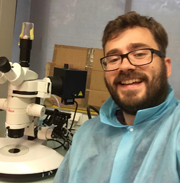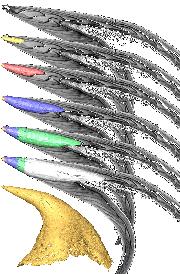Dr Duncan Murdock, Leverhulme Early Career Fellow

Email: duncan.murdock@oum.ox.ac.uk
Phone: +44 (0)1865 272995
Research summary
My research is focused on using the fossil record to understand the early evolution of skeletons in animals. The earliest unequivocal animal fossils appear in the rock record almost ‘overnight’, largely in the form of microscopic disarticulated skeletal elements, an event known as the Cambrian Explosion. Locked within these shells, teeth and bones is a record of the expression of the molecular and developmental machinery that drove this event. By using high magnification electron microscopes and 3d x-ray imaging I can peer into the tiny differences in their microscopic internal structures and measure the variability of the shape of individual teeth, spines and shells. Using these data, I am able to disentangle the ecological, environmental and developmental drivers of the origination and diversification of biomineralization in animals.
Biography
- MGeol (Hons) Geology with Palaeobiology (University of Leicester, 2008)
- PhD Evolution of the skeleton and the origin of animal phyla (University of Bristol, 2012)
- NERC Research Assistant (University of Leicester, 2011-2012)
- NERC Research Assistant (University of Bristol, 2012-2013)
- Teaching Fellow (University of Bath, 2013)
- NERC Research Associate (University of Leicester, 2013-2016)
Selected publications
Murdock, D. J. E., Gabbott, S. E. and Purnell, M. A. 2016. The impact of taphonomic data on phylogenetic resolution: Helenodora inopinata (Carboniferous, Mazon Creek Lagerstätte) and the onychophoran stem lineage. BMC Evolutionary Biology, 16:19.
Murdock, D. J. E., Gabbott, S. E., Mayer, G. and Purnell, M. A. 2014. Decay of velvet worms (Onychophora), and bias in the fossil record of lobopodians. BMC Evolutionary Biology, 14:222.
Murdock, D. J. E., Rayfield, E. J. and Donoghue, P. C. J. 2014. Functional adaptation underpinned the evolutionary assembly of the earliest vertebrate skeleton. Evolution & development, 16, 354–361.
 Peering inside the earliest ‘teeth’. Here each growth stage of the tooth-like element of the early vertebrate Problematoconites has been digitally dissected based on x-ray images of its internal structure. Modified from Murdock & Donoghue, 2012, Nature.
Peering inside the earliest ‘teeth’. Here each growth stage of the tooth-like element of the early vertebrate Problematoconites has been digitally dissected based on x-ray images of its internal structure. Modified from Murdock & Donoghue, 2012, Nature.
Murdock, D. J. E., Bengtson, S., Marone, F, Greenwood, J. M. and Donoghue, P. C. J. 2014. Evaluating scenarios for the evolutionary assembly of the brachiopod body plan. Evolution and Development, 16, 13-24.
Murdock, D. J. E., Dong, X.-P., Repetski, J. E., Marone, F., Stampanoni, M., Donoghue, P. C. J. 2013. The origin of conodonts and of vertebrate mineralized skeletons. Nature, 502, 546-549.
Murdock, D. J. E., Sansom, I. J. and Donoghue, P. C. J. 2013. Cutting the first ‘teeth’ – a new approach to functional analysis of conodont elements. Proceedings of the Royal Society B, 280: 20131524.
Aldridge, R. J., Murdock, D. J. E., Gabbott, S. E. and Theron, J. N. 2013. A seventeen-element conodont apparatus from the Soom Shale lagerstätte (Upper Ordovician), South Africa. Palaeontology, 56, 261-276.
Murdock, D. J. E., Donoghue, P. C. J., Bengtson, S. and Marone, F. 2012. Ontogeny and microstructure of the enigmatic Cambrian tommotiid Sunnaginia Missarzhevsky 1969. Palaeontology, 55, 661-676.
Murdock, D. J. E. and Donoghue, P. C. J. 2011. Evolutionary origins of animal skeletal biomineralization. Cells Tissues Organs, 2-4, 98-102.
Affiliations
The Geological Society, London (Fellow)
The Palaeontological Association
European Geosciences Union
Linacre College, University of Oxford
